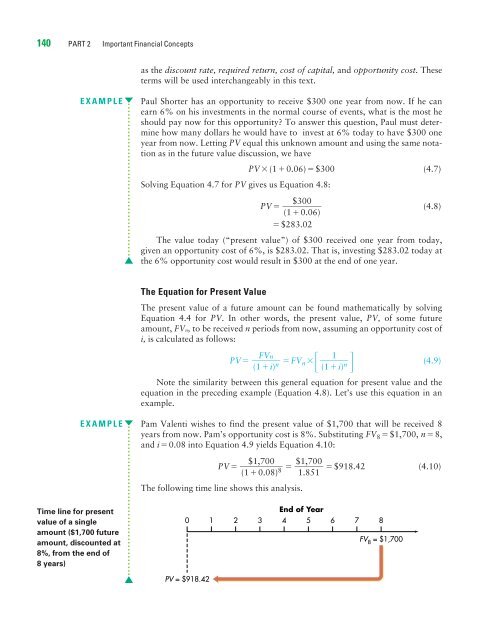Read the Chapter 4 E-Book
Read the Chapter 4 E-Book
Read the Chapter 4 E-Book
You also want an ePaper? Increase the reach of your titles
YUMPU automatically turns print PDFs into web optimized ePapers that Google loves.
140 PART 2 Important Financial Concepts<br />
as <strong>the</strong> discount rate, required return, cost of capital, and opportunity cost. These<br />
terms will be used interchangeably in this text.<br />
EXAMPLE Paul Shorter has an opportunity to receive $300 one year from now. If he can<br />
earn 6% on his investments in <strong>the</strong> normal course of events, what is <strong>the</strong> most he<br />
should pay now for this opportunity? To answer this question, Paul must determine<br />
how many dollars he would have to invest at 6% today to have $300 one<br />
year from now. Letting PV equal this unknown amount and using <strong>the</strong> same notation<br />
as in <strong>the</strong> future value discussion, we have<br />
PV (1 0.06) $300 (4.7)<br />
Solving Equation 4.7 for PV gives us Equation 4.8:<br />
$300<br />
PV <br />
(4.8)<br />
(1 0.06)<br />
$283.02<br />
The value today (“present value”) of $300 received one year from today,<br />
given an opportunity cost of 6%, is $283.02. That is, investing $283.02 today at<br />
<strong>the</strong> 6% opportunity cost would result in $300 at <strong>the</strong> end of one year.<br />
The Equation for Present Value<br />
The present value of a future amount can be found ma<strong>the</strong>matically by solving<br />
Equation 4.4 for PV. In o<strong>the</strong>r words, <strong>the</strong> present value, PV, of some future<br />
amount, FVn, to be received n periods from now, assuming an opportunity cost of<br />
i, is calculated as follows:<br />
FVn<br />
<br />
(1 i) n<br />
1<br />
<br />
(1 i) n<br />
PV FV n (4.9)<br />
Note <strong>the</strong> similarity between this general equation for present value and <strong>the</strong><br />
equation in <strong>the</strong> preceding example (Equation 4.8). Let’s use this equation in an<br />
example.<br />
EXAMPLE Pam Valenti wishes to find <strong>the</strong> present value of $1,700 that will be received 8<br />
years from now. Pam’s opportunity cost is 8%. Substituting FV8$1,700, n8,<br />
and i0.08 into Equation 4.9 yields Equation 4.10:<br />
$1,700 $1,700<br />
PV $918.42 (4.10)<br />
(1 0.08) 8 1.851<br />
The following time line shows this analysis.<br />
Time line for present<br />
value of a single<br />
amount ($1,700 future<br />
amount, discounted at<br />
8%, from <strong>the</strong> end of<br />
8 years)<br />
0 1 2 3 4 5 6 7 8<br />
PV = $918.42<br />
End of Year<br />
FV 8 = $1,700

















